The animal kingdom still holds many secrets from us, humans. There are so many representants that is we barely know… they are so unique, sometimes so bizarre looking , but most of all extremally interesting. I love animals, and since I was a kid, we always watches nature shows in my home… till this day is something that is I do … just the part of who I am …I guess… nevertheless I will never miss a chance to watch another one, or most of all to learn something new about an amazing world of animals….
So, the idea came to me, to bring you some of the most amazingly looking animals, the bizarre looking ones or the weird or strange ones… let us discover what Mothers Nature created for us.
*** MEET THE ANIMALS***
Shoebill
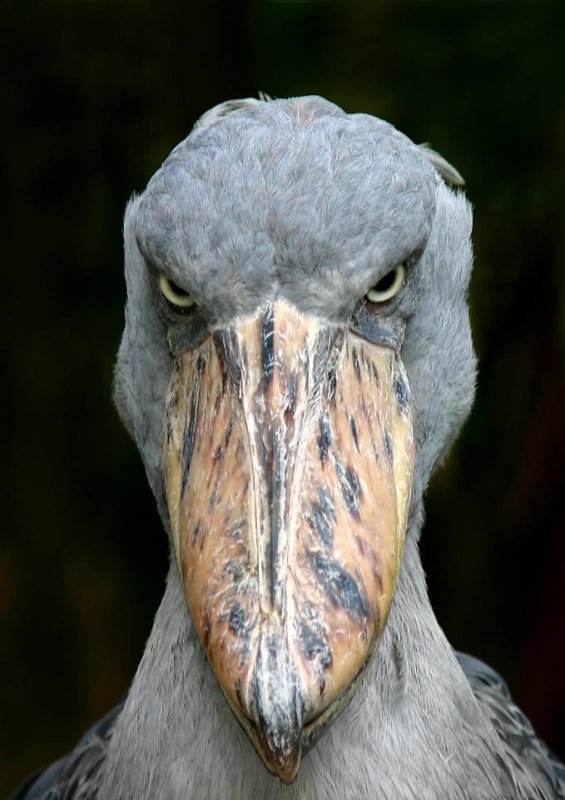
Also known as the Whalehead or Shoe-billed Stork. This large bird is named for the shoe-like shape of its humongous bill, which allow it to catch surprisingly large prey. The species was only discovered in the 19th century when some skins were brought to Europe. It was not until years later that live specimens reached the scientific community. The bird was known to both ancient Egyptians. They are found in east Africa, primarily in large tropical swamps from Sudan south to Zambia. With a height of 43 to 55 inches and a wingspan up to 8 feet 6 inches, these funny looking birds are hard to miss.
The Emperor Tamarin
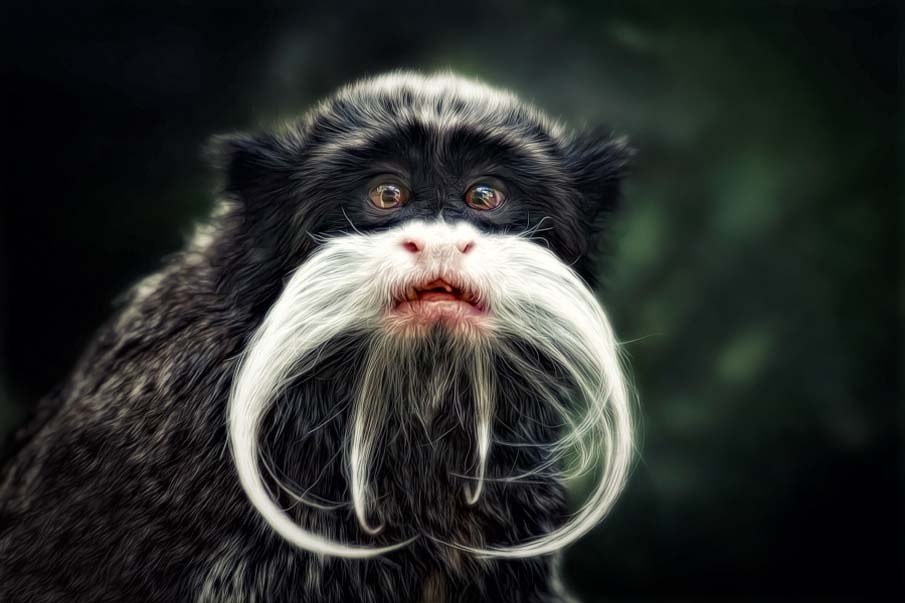
(Saguinus imperator) This tamarin lives in the southwest Amazon Basin, in east Peru, north Bolivia and in the west Brazilian states of Acre and Amazonas. The emperor tamarin is most widely known for her elegant, white mustache. Her thick, brindled fur can vary from grayish yellow to silvery-gray with a reddish-gold tail. Often, she has a white tuft of fur along her underside.
*FUN FACT: is a tamarin allegedly named for its similarity with the German emperor Wilhelm II. The name was first intended as a joke but has become the official scientific name.
Yeti Crab
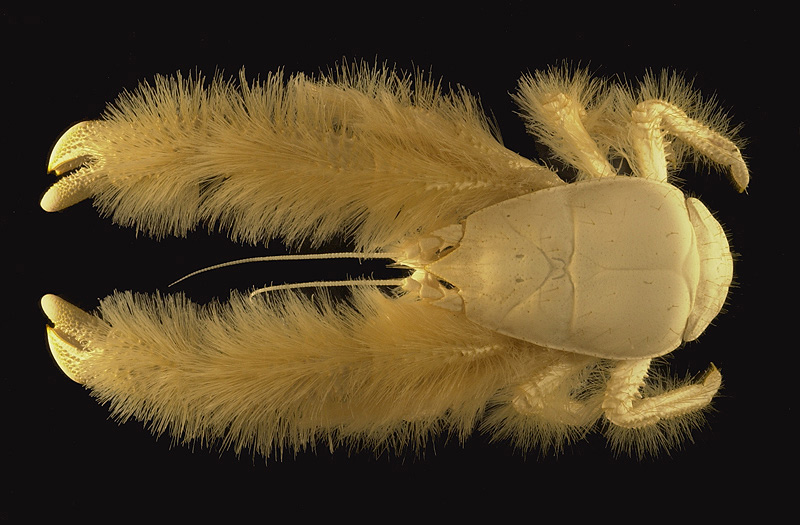
Kiwa hirsuta is a crustacean discovered in 2005 in the South Pacific Ocean. This decapod, which is approximately 15 cm (6 inches) long, is notable for the large quantity of silky blond setae (resembling fur) covering its pereiopods .
Jumping Stick
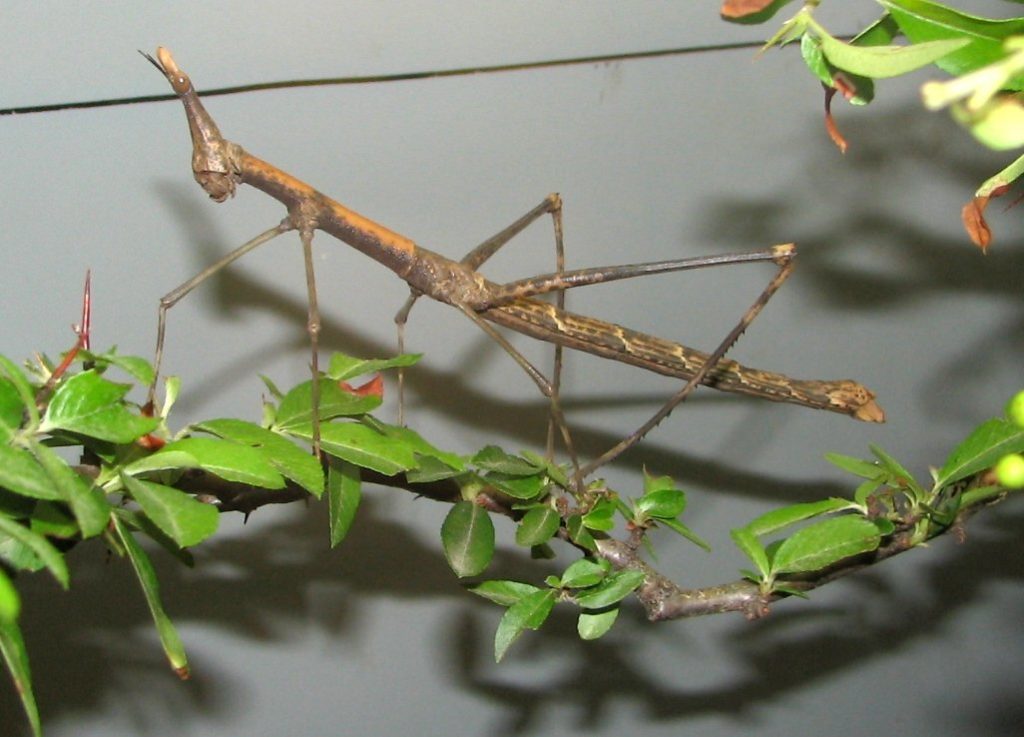
These insects are named for their interesting camouflage technique. They blend into woody plants where they feed. Stick insects even imitate twigs swaying in the wind by rocking back and forth as they move. They are typically brown, black, or green, with stick-shaped bodies that help them blend in as they perch on twigs and branches. They are found in south and southeast Asia to New Zealand.
The Mary River turtle
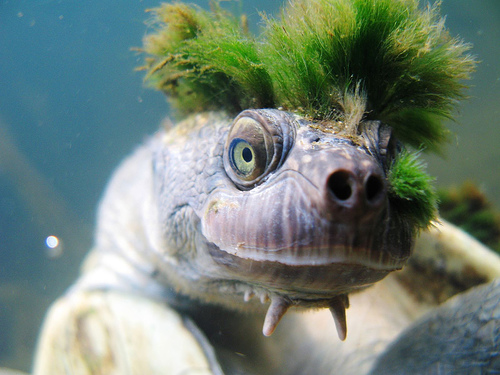
This is one of Australia’s largest turtles. Specimens in excess of 50 cm carapace length have been recorded. A unique feature of male Mary River turtles is the tail, which can measure almost two-thirds of the carapace length. The tail has haemal arches, a feature lost in all other modern turtles. Besides awesome algae-mohawk, this turtle when is not breathing normally above water, has an ability to breath underwater using gill-like structures near their cloaca ( behind).
Aye Aye
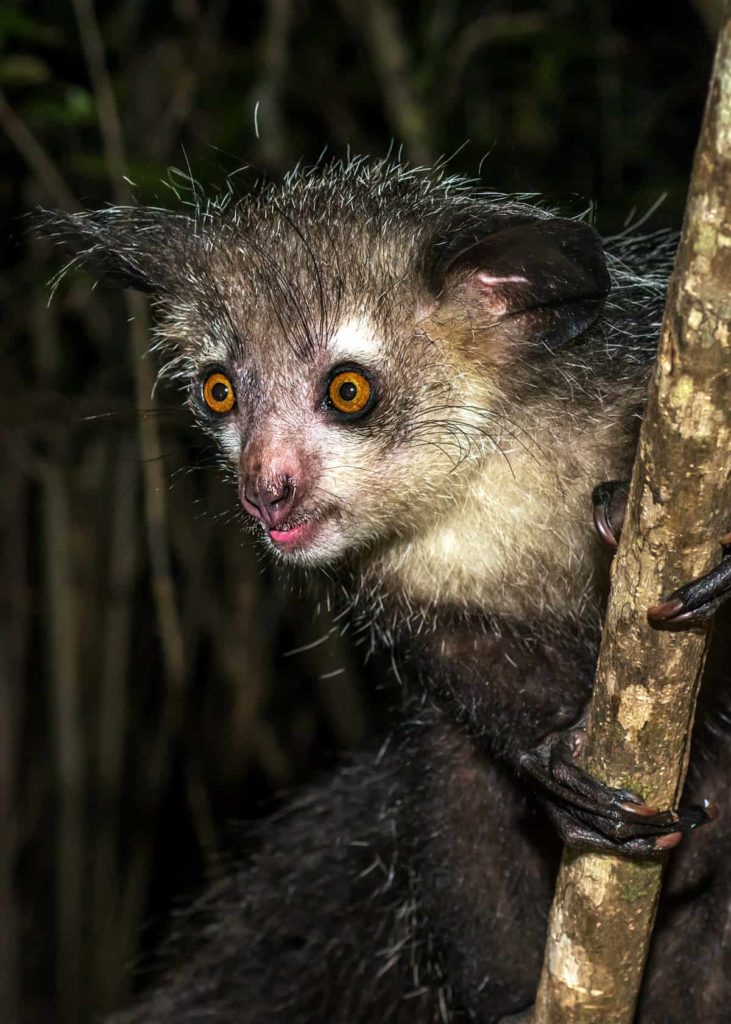
Inhabitant of Madagascar – aye-aye monkey, known as the Madagascar fingerlings. It is the world’s largest example of a nocturnal primate. It is the size of an average cat, and characteristically has a long middle finger with a hooked claw, which it uses to search for larvae in the bark of trees. These endangered Lemurs are the world’s largest nocturnal primate and have furry gremlin faces, rodent-like teeth, and long Crypt Keeper-style fingers.
Ocean Sunfish

The fish called mola mola in Japanese is considered a great delicacy in the cherry blossom country of Korea and Taiwan. It is the heaviest known bone-skeleton fish, it can reach up to 3 meters in length and weighs up to 2 tons! Due to its weight, it swims very slowly and often on its side. Female sunfish can produce up to 300 million eggs at a time – the most of any vertebrate!
Markhor
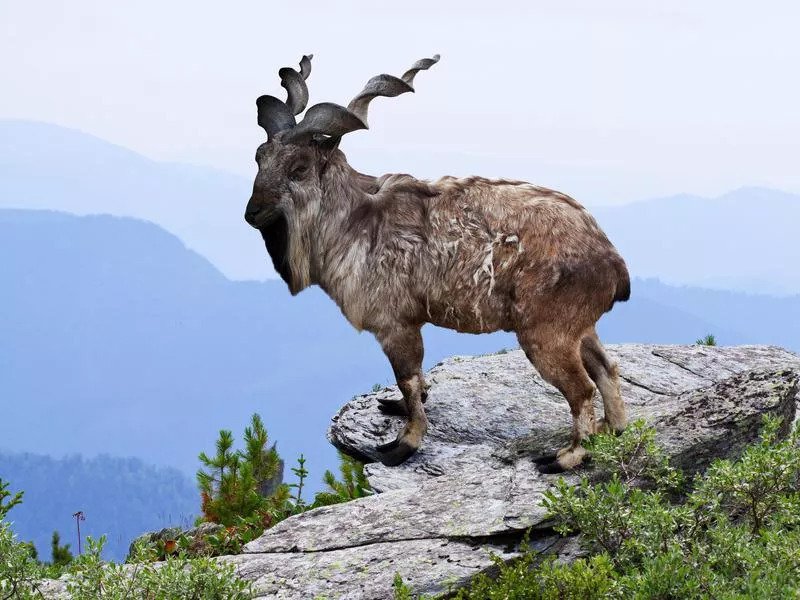
The national animal of Pakistan, the Markhor is a sizable species of wild goat. The majestic beast’s most distinguishing feature is its massive spiral horns that can grow to be up to five feet long. They are on the endangered list, with less than 2,500 mature animals in existence.
Fossa

Fossas live in Madagascar, and their looks like a cross between a cat and a ferret, with a little bit of cougar thrown into the mix. Being a carnivore, they are very sleek and muscular, are able to chase down prey with the greatest of ease.
Patagonian Mara
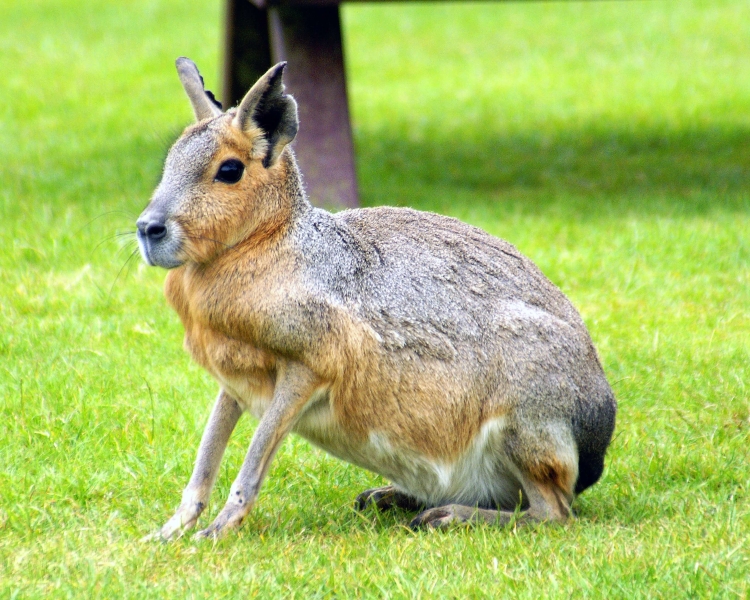
It is also known as the Patagonian cavy, Patagonian hare, or dillaby. This furry rodent who greatly resembles a rabbit with long, spindly legs. They live in Argentina and large parts of Patagonia, mostly under the cover of shrubbery. Like common rabbits, they are also herbivores.
Saiga Antelope
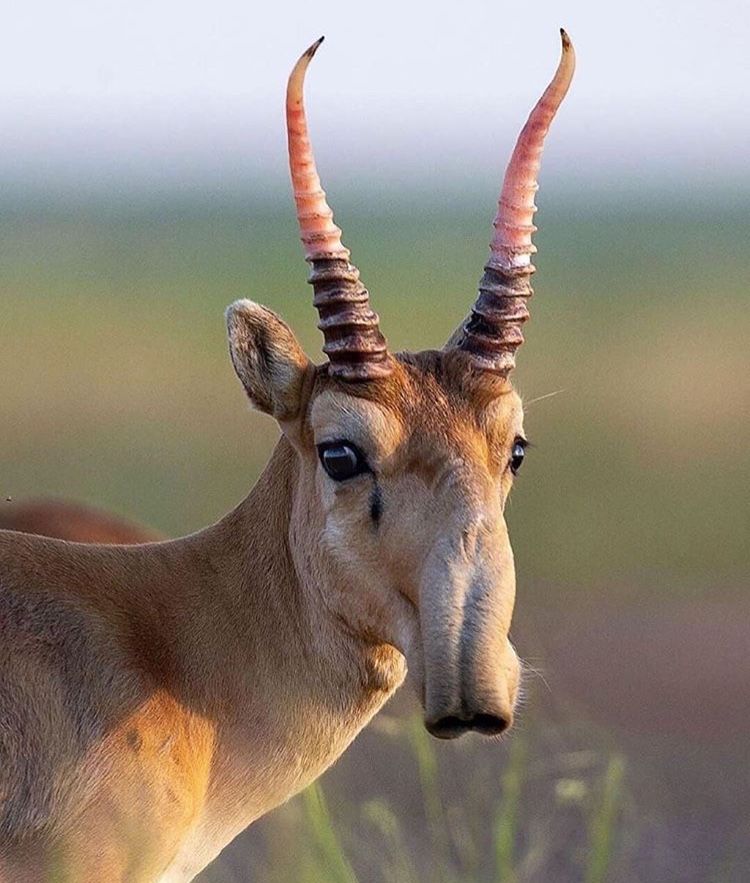
Yes we all see this nose. huge and humped over the mouth. This weird-looking nose serves a purpose of protecting the saiga’s lungs from getting filled up with dust in the deserts and arid grasslands where it lives. It also cools hot summer air and warms cold winter air. They travel in herds of around 30 to 40 individuals that usually consist of a dominant male and his harem of females and their young. Saigas are well known for their long, annual migrations where they can cover up 72 miles per day by running and swimming across rivers.
Tree Kangaroo
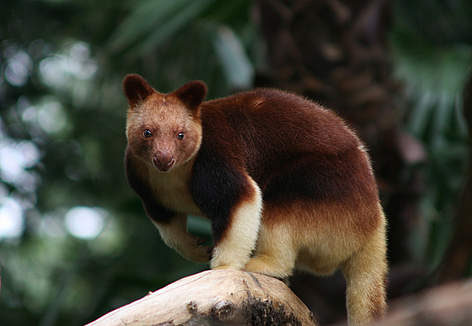
These cuties are in the marsupial family and are usually found in the tropical regions of New Guinea. There are also 12 different species of tree kangaroos, with some species found in Australia. Depending on the species of tree kangas they can top out at 22 pounds! That is like a small dog! They mostly eat leaves and fruits, but will also eat grains, flowers, eggs, young birds, and even bark.
Tarsier
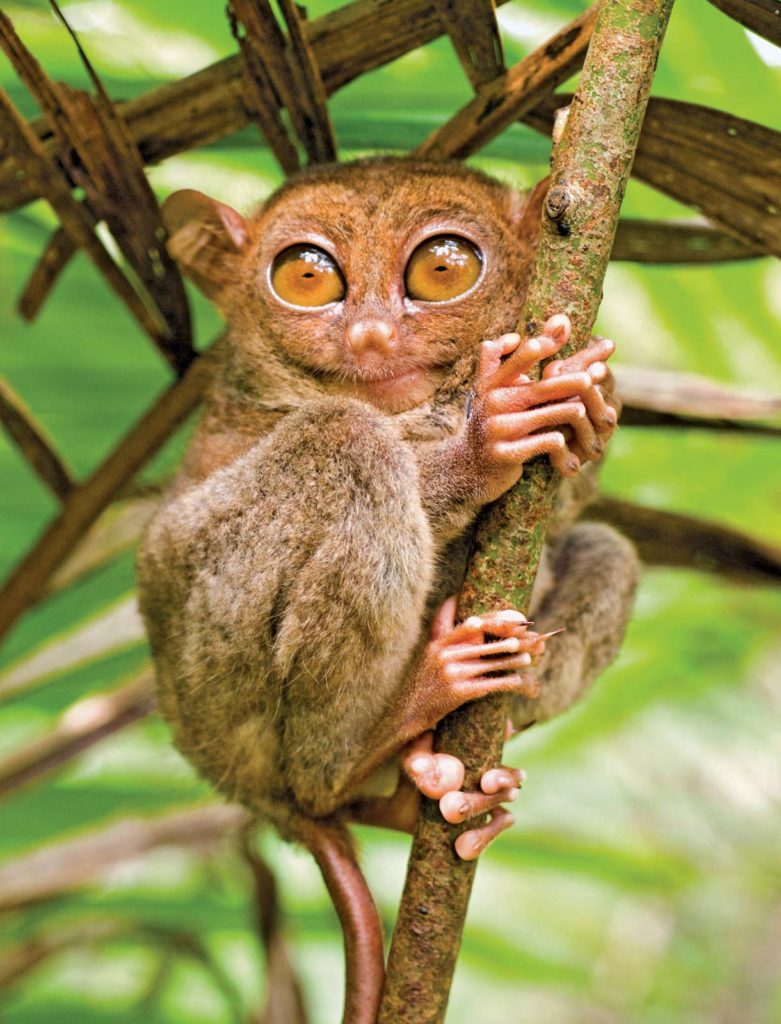
In the past all members of its family of species were living today are found in the islands of Southeast Asia, specifically the Philippines, Malaysia, Indonesia, and Brunei. Tarsiers are small animals with enormous eyes; they are primarily insectivorous and catch insects by jumping at them. Their favorite prey are arthropods like beetles, spiders, cockroaches, grasshoppers, and walking sticks. They are also known to prey on birds, snakes, lizards, and bats
Mantis Shrimp
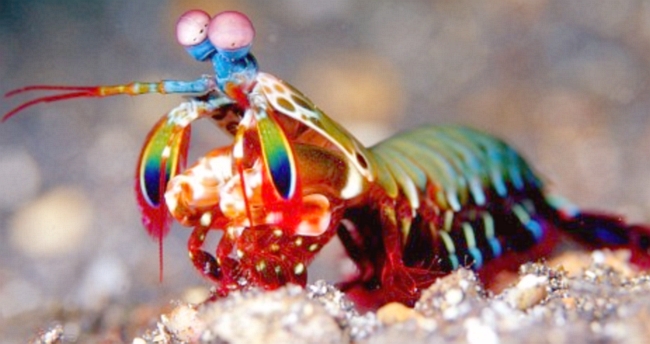
This animal is totally unique in its appearance. It look kind off like a cross between a crayfish, a praying mantis, and a colorful parrot, but the Mantis Shrimp is not to be played with. Its raptorial tentacles move so quickly, they literally boil the water around them, producing shockwaves strong enough to kill prey!
Kinkajou
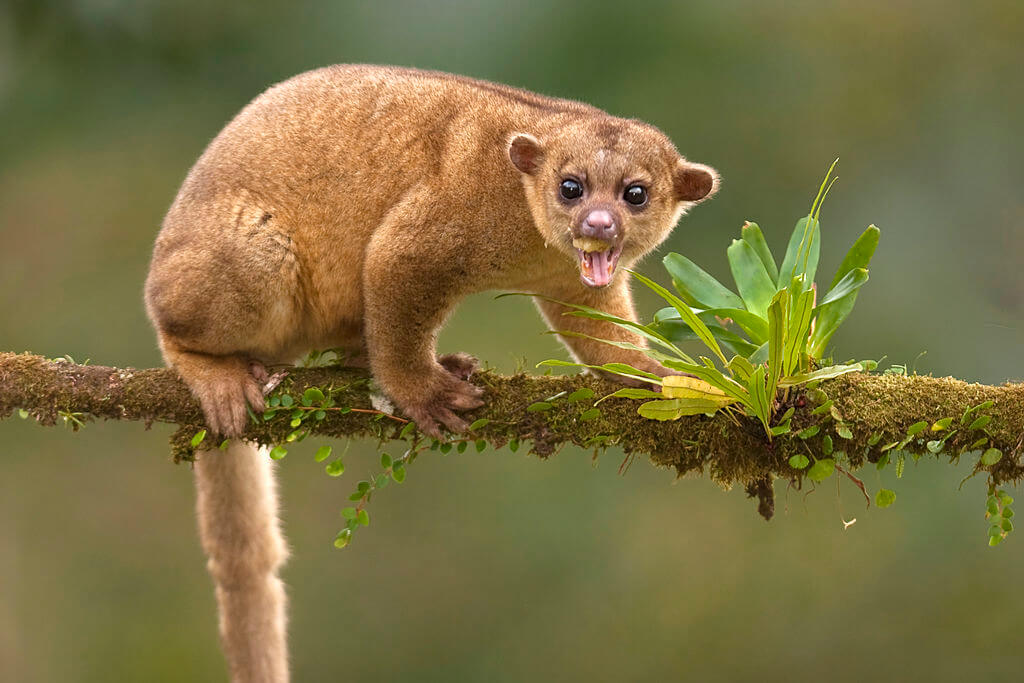
Kinkajous live in the tropical forests of Central and South America. They spend most of their time up in the trees! Fun fact, they can turn their feet backwards to run more easily in either direction along the features of trees. Their tail is also very “handy.” It is essentially a fifth arm that can grip things very easily, kind of like a monkey. It is called a prehensile tail.
Zebra Duiker
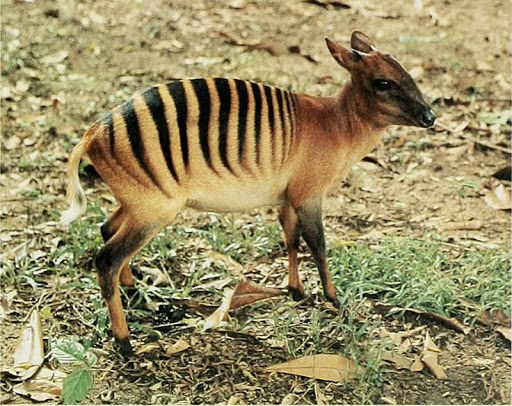
sometimes referred to as the banded duiker or striped-back duiker. It is a small antelope found primarily in Liberia, as well as the Ivory Coast, Sierra Leone, and occasionally Guinea. Their Zebra-like stripes help them hide from the many predators that eat them. They also have super-powerful nasal bones, which allow them to use their face to crack open the tough exterior of certain fruits.
Axolotl

Also known as the Mexican Walking Fish, this amphibious salamander is critically endangered, and nearly went extinct in 2010. They are weird animals because they do not go into metamorphosis like other salamanders: Even adults remain aquatic and gilled. They’re frequently used for research by scientists due to their ability to regenerate limbs.
Pangolin

These interesting looking creatures are Pangolins. The scale looking things they have on their backs are large, protective scales that cover their skin. They are the only mammals that have this sort of feature — makes them look like a dinosaur. Like anteaters, they eat ants and termites using a long, sticky tongue. And like armadillos, they can roll up in a ball with threatened. They are also nocturnal animals that feed during the night.
Blobfish

This creature is not a fast swimmer. It does not even have to swim most of the time, as its body tissue is slightly less dense than water, allowing it to float effortlessly just off the bottom of the ocean, waiting for its dinner of microorganisms to float by. How does it survive not being eaten? By not being tasty. In fact, it is inedible to humans. It is still endangered though; overfishing of the ocean bottom leads to these guys being hauled out of the ocean at a fast rate.
Chinese Water Deer
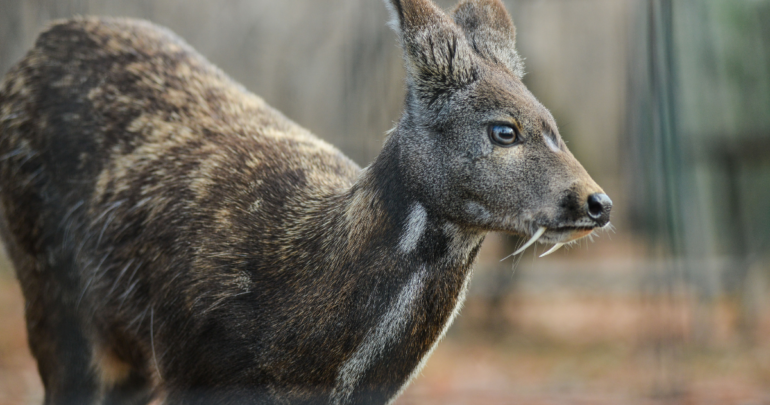
The protruded fangs on the male of this species give the illusion that they are carnivores, but they eat grass like most deer. A close relative to the muntjac and usually found in China, they are being overhunted and slowly losing their habitat, but luckily they have not made it onto the endangered species list yet.
Okapi
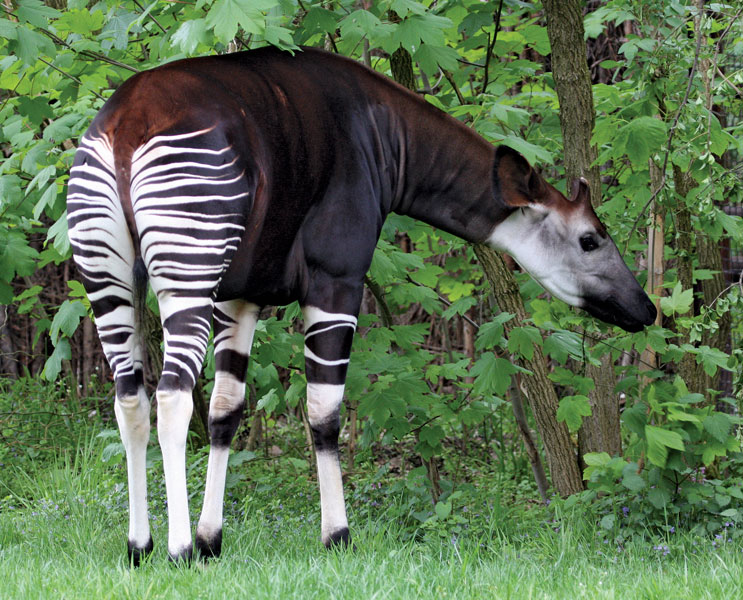
Is it a Zebra , or is it a Giraffe??? Well ? The okapi is the only living relative of the giraffe but features the distinctive black-and-white markings of the zebra on its hindquarters and front legs. Its nickname? The “zebra giraffe”, obviously. This endangered animal is leery of humans and hard to find (so much so that scientists did not discover the okapi until 1900). It lives in the Uturi Forest in the Democratic Republic of Congo, but travelers cannot access this area. Instead, head to the White Oak Conservation Center in Florida, which focuses on the conservation of okapi, and book a tour led by a wildlife expert.
Japanese Spider Crab

This is a species of marine crab that lives in the waters around Japan. It has the largest leg span of any arthropod ( animal having exoskeleton). The Japanese name for this species is taka-ashi-gani, which literally translates to “tall legs crab.” These crazy animals– whose legs can span 12 feet in length, weigh up to 42 pounds, and crawl along the ocean floor like a creepy spider. Orange, with white spots along the legs, these crabs reportedly have a very gentle disposition despite their daunting appearance.
Coati Mundi
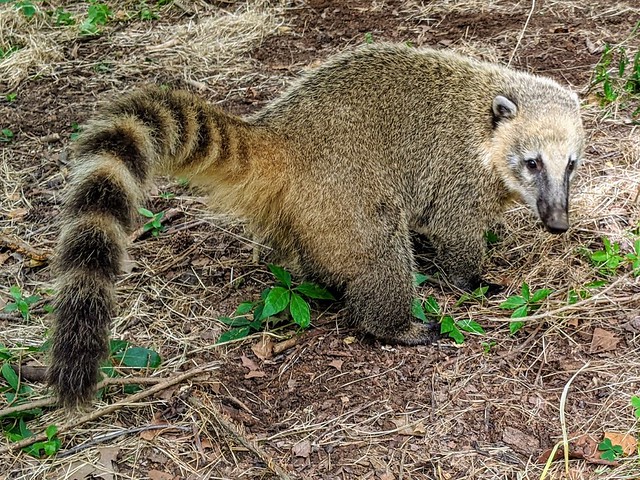
members of the raccoon family. But unlike the raccoon, they sleep during the night and do their hunting in the daylight. They are mostly found in South America. They are also omnivorous animals, meaning they eat fruits, invertebrates, and other small animals. There are also four different species of the coati mundi.
Bush Viper
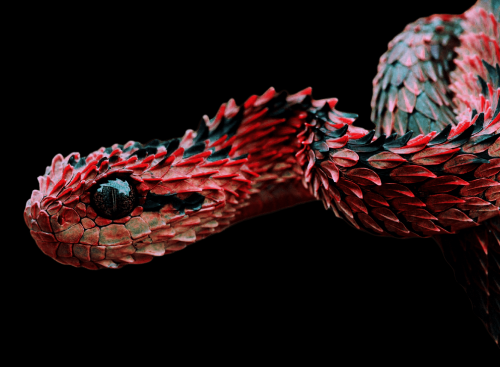
are found in the forests of Nigeria to Western Kenya and other areas in Tanzania and Angola. It is an arboreal animal, meaning that it lives in the trees and can be seen as many different colors as possible. There are many different subspecies of bush vipers. It is also a very venomous viper.
Bat-eared Fox
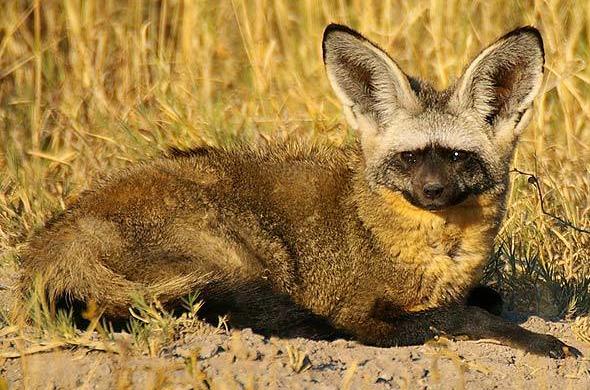
These tawny-furred animals with their bushy tails and dark face masks love feasting on termites which makes local farmers incredibly happy. When they are not foraging, they like to lounge under acacia trees. They are filled with blood vessels that regulate heat and keep the fox cool. The ears also provide the fox with such incredible hearing that it can actually hear beetle eggs hatching out from dung balls.
Narwhal
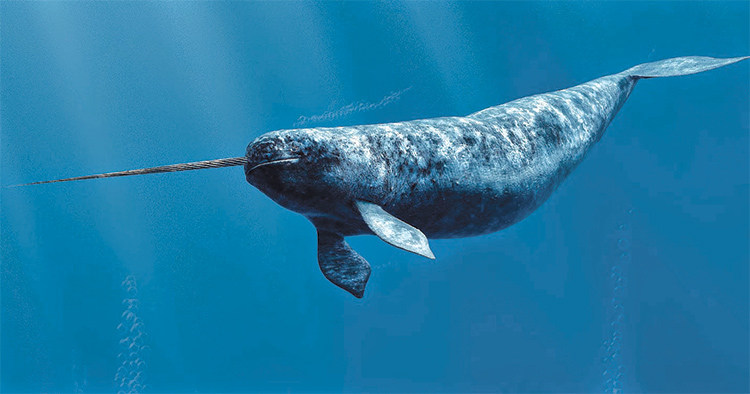
Those Unicorn looking creatures can live only in extremely cold waters of Russia, Norway, Canada, and Greenland (particularly Baffin Bay). What makes Narwhal so unique, it is their tusk. In reality it is a long tooth and can grow up to 10 feet long and spirals as it grows.
Aardvark

This A shy animal lives in sub-Saharan Africa. It has a snout like a pig, ears like a rabbit, a tail like a kangaroo, webbed feet like a duck, and a tongue like an anteater. A lonely, nocturnal mammal that digs shallow, underground tunnels to hide in by day, the aardvark goes out at night searching for ants and termites.
Long-Wattled Umbrellabird
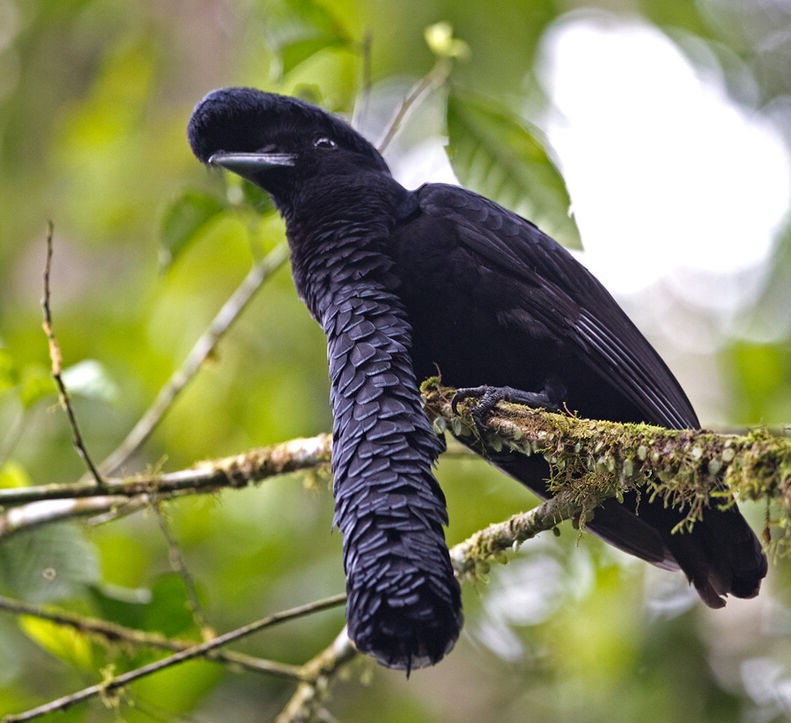
Those bizarre looking birds can be found in the humid forests of Colombia and Ecuador. The males have a magnificent coiff-like crest Elvis would kill for, with hair-like feathers that extend out over their bill. Their wattle is even weirder: It is long, black, and hangs down 16 to 17 inches from the middle of their chest. They can inflate it during courtship rituals to draw attention or retract it against their chest during flight.
Sulawesi Babirusas

Babyrousa, belong to the swine family found in the Indonesian islands of Sulawesi, Togian, Sula and Buru; Native to the rainforests and swamps. The remarkable “prehistoric” appearance of these mammals is largely due to the prominent upwards incurving canine tusks of the males, which actually pierce the flesh in the snout; these unusual animals are not picky eaters. Their diet consists of everything from leaves and insects to fish, and even smaller Babirusas! Their antler-like teeth, along with a stocky body and slender legs, led to their name: Babirusas means “pig-deer” in the Malay language.
Orchid Mantis

Found in countries of southern and eastern Asia, the orchid mantis is truly a master of disguise. It is a praying mantis that looks exactly like the beautiful, pink, and white orchid flower. Even its legs resemble flower petals. It makes predators think it is a flower, and it attracts prey.
Pacu Fish
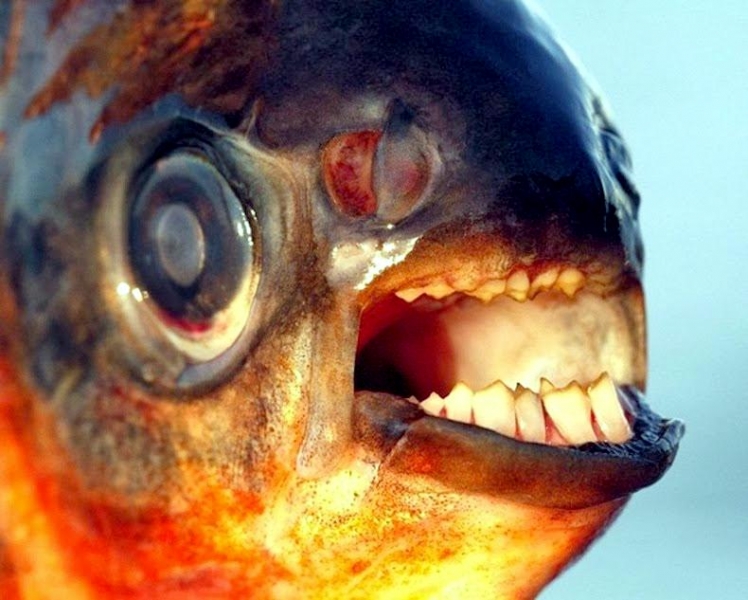
Very often this fish is confused with piranha fish because its body shape. But there is one bog difference. Pacu fish have teeth that look freakishly like human teeth. It lives mainly in the Amazon River regions.
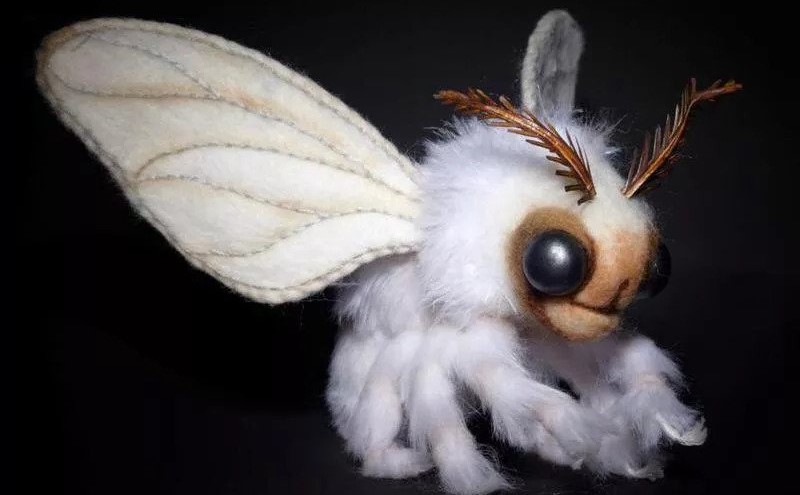



Some of these are kinda creepy some are really cute. Good info! Nice blog.
I love it 👍
I never knew those kind of animals exist.